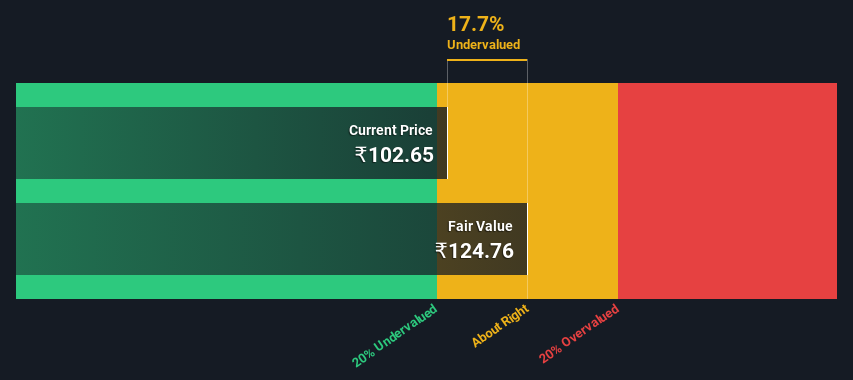- India
- /
- Metals and Mining
- /
- NSEI:ELECTHERM
Estimating The Fair Value Of Electrotherm (India) Limited (NSE:ELECTHERM)

Key Insights
- The projected fair value for Electrotherm (India) is ₹125 based on 2 Stage Free Cash Flow to Equity
- Electrotherm (India)'s ₹103 share price indicates it is trading at similar levels as its fair value estimate
- Electrotherm (India)'s peers are currently trading at a premium of 275% on average
Does the August share price for Electrotherm (India) Limited (NSE:ELECTHERM) reflect what it's really worth? Today, we will estimate the stock's intrinsic value by taking the forecast future cash flows of the company and discounting them back to today's value. One way to achieve this is by employing the Discounted Cash Flow (DCF) model. Don't get put off by the jargon, the math behind it is actually quite straightforward.
Companies can be valued in a lot of ways, so we would point out that a DCF is not perfect for every situation. For those who are keen learners of equity analysis, the Simply Wall St analysis model here may be something of interest to you.
View our latest analysis for Electrotherm (India)
The Calculation
We use what is known as a 2-stage model, which simply means we have two different periods of growth rates for the company's cash flows. Generally the first stage is higher growth, and the second stage is a lower growth phase. To begin with, we have to get estimates of the next ten years of cash flows. Seeing as no analyst estimates of free cash flow are available to us, we have extrapolate the previous free cash flow (FCF) from the company's last reported value. We assume companies with shrinking free cash flow will slow their rate of shrinkage, and that companies with growing free cash flow will see their growth rate slow, over this period. We do this to reflect that growth tends to slow more in the early years than it does in later years.
Generally we assume that a dollar today is more valuable than a dollar in the future, and so the sum of these future cash flows is then discounted to today's value:
10-year free cash flow (FCF) forecast
| 2024 | 2025 | 2026 | 2027 | 2028 | 2029 | 2030 | 2031 | 2032 | 2033 | |
| Levered FCF (₹, Millions) | ₹499.5m | ₹406.0m | ₹361.1m | ₹340.5m | ₹333.9m | ₹336.1m | ₹344.6m | ₹357.6m | ₹374.4m | ₹394.4m |
| Growth Rate Estimate Source | Est @ -29.65% | Est @ -18.72% | Est @ -11.06% | Est @ -5.70% | Est @ -1.95% | Est @ 0.67% | Est @ 2.51% | Est @ 3.80% | Est @ 4.70% | Est @ 5.33% |
| Present Value (₹, Millions) Discounted @ 26% | ₹396 | ₹255 | ₹179 | ₹134 | ₹104 | ₹83.0 | ₹67.4 | ₹55.4 | ₹45.9 | ₹38.3 |
("Est" = FCF growth rate estimated by Simply Wall St)
Present Value of 10-year Cash Flow (PVCF) = ₹1.4b
The second stage is also known as Terminal Value, this is the business's cash flow after the first stage. The Gordon Growth formula is used to calculate Terminal Value at a future annual growth rate equal to the 5-year average of the 10-year government bond yield of 6.8%. We discount the terminal cash flows to today's value at a cost of equity of 26%.
Terminal Value (TV)= FCF2033 × (1 + g) ÷ (r – g) = ₹394m× (1 + 6.8%) ÷ (26%– 6.8%) = ₹2.2b
Present Value of Terminal Value (PVTV)= TV / (1 + r)10= ₹2.2b÷ ( 1 + 26%)10= ₹210m
The total value, or equity value, is then the sum of the present value of the future cash flows, which in this case is ₹1.6b. In the final step we divide the equity value by the number of shares outstanding. Relative to the current share price of ₹103, the company appears about fair value at a 18% discount to where the stock price trades currently. Remember though, that this is just an approximate valuation, and like any complex formula - garbage in, garbage out.

Important Assumptions
The calculation above is very dependent on two assumptions. The first is the discount rate and the other is the cash flows. If you don't agree with these result, have a go at the calculation yourself and play with the assumptions. The DCF also does not consider the possible cyclicality of an industry, or a company's future capital requirements, so it does not give a full picture of a company's potential performance. Given that we are looking at Electrotherm (India) as potential shareholders, the cost of equity is used as the discount rate, rather than the cost of capital (or weighted average cost of capital, WACC) which accounts for debt. In this calculation we've used 26%, which is based on a levered beta of 2.000. Beta is a measure of a stock's volatility, compared to the market as a whole. We get our beta from the industry average beta of globally comparable companies, with an imposed limit between 0.8 and 2.0, which is a reasonable range for a stable business.
SWOT Analysis for Electrotherm (India)
- No major strengths identified for ELECTHERM.
- Interest payments on debt are not well covered.
- Has sufficient cash runway for more than 3 years based on current free cash flows.
- Current share price is below our estimate of fair value.
- Lack of analyst coverage makes it difficult to determine ELECTHERM's earnings prospects.
- Debt is not well covered by operating cash flow.
- Total liabilities exceed total assets, which raises the risk of financial distress.
Moving On:
Valuation is only one side of the coin in terms of building your investment thesis, and it shouldn't be the only metric you look at when researching a company. The DCF model is not a perfect stock valuation tool. Rather it should be seen as a guide to "what assumptions need to be true for this stock to be under/overvalued?" If a company grows at a different rate, or if its cost of equity or risk free rate changes sharply, the output can look very different. For Electrotherm (India), we've compiled three further elements you should consider:
- Risks: Every company has them, and we've spotted 4 warning signs for Electrotherm (India) (of which 3 are a bit concerning!) you should know about.
- Other High Quality Alternatives: Do you like a good all-rounder? Explore our interactive list of high quality stocks to get an idea of what else is out there you may be missing!
- Other Top Analyst Picks: Interested to see what the analysts are thinking? Take a look at our interactive list of analysts' top stock picks to find out what they feel might have an attractive future outlook!
PS. Simply Wall St updates its DCF calculation for every Indian stock every day, so if you want to find the intrinsic value of any other stock just search here.
Valuation is complex, but we're here to simplify it.
Discover if Electrotherm (India) might be undervalued or overvalued with our detailed analysis, featuring fair value estimates, potential risks, dividends, insider trades, and its financial condition.
Access Free AnalysisHave feedback on this article? Concerned about the content? Get in touch with us directly. Alternatively, email editorial-team (at) simplywallst.com.
This article by Simply Wall St is general in nature. We provide commentary based on historical data and analyst forecasts only using an unbiased methodology and our articles are not intended to be financial advice. It does not constitute a recommendation to buy or sell any stock, and does not take account of your objectives, or your financial situation. We aim to bring you long-term focused analysis driven by fundamental data. Note that our analysis may not factor in the latest price-sensitive company announcements or qualitative material. Simply Wall St has no position in any stocks mentioned.
About NSEI:ELECTHERM
Electrotherm (India)
An engineering company, engages in provision of steel melting solutions worldwide.
Good value with acceptable track record.
Similar Companies
Market Insights
Community Narratives



